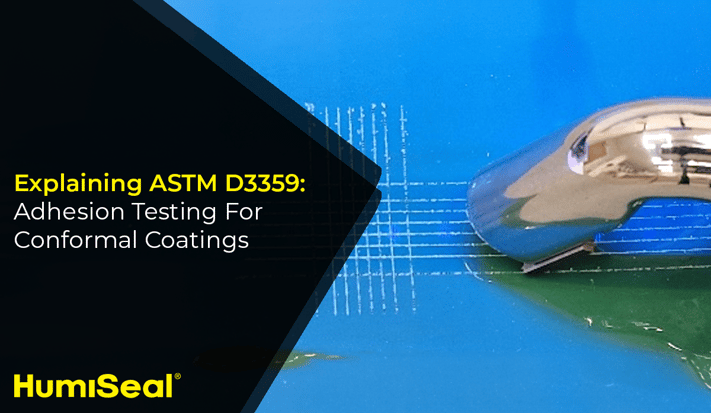
Conformal coatings offer tremendous protection to printed circuit board assemblies, but this assumes they properly adhere to the PCB. Application errors are all too common, causing delamination and otherwise poor adhesion of the material. So before producing at scale, you should routinely conduct adhesion tests to validate the integrity of your production processes.
This blog will cover the hows and whys of adhesion testing. Specifically, we will explore the following:
- Benefits of Adhesion Testing
- Causes of Delamination
- Reviewing ASTM D3359 and Required Tools
- Performing and Interpreting Adhesion Tests
What is PCB Adhesion Testing?
Adhesion testing evaluates conformal coating material's ability to adhere or "stick" onto substrates (such as PCB solder masks and components). This test can predict the long-term performance of the coatings in highly demanding environmental conditions.
Ultimately, the level of adhesion directly impacts the grade of the PCB, the integrity of the manufacturing process, and the quality of the conformal coating application.
ASTM D3359 is the referenced standard for adhesion testing. This standard is also referenced in the IPC-HDBK-830. It's important to note that adhesion testing is not a required part of IPC-CC-830 Rev. C or IPC-A-610.
Two major concerns adhesion testing evaluates are delamination and conformal coating pealing, pictured below.
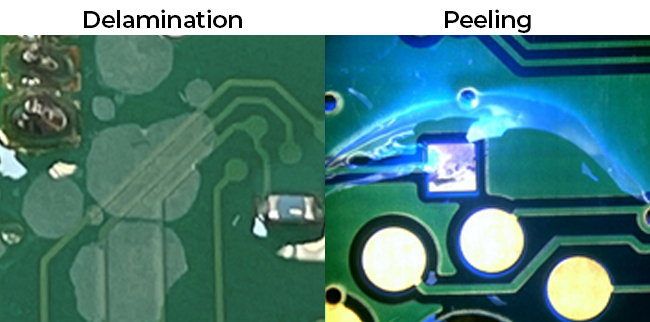
So adhesion testing can help predict the likelihood of delamination, but what causes delamination in the first place?
3 Main Causes of Delamination
Delamination is the splitting and subsequent separation of the layer of conformal coating material and PCB. It represents a severe failure in performance and must be avoided. Some common causes of delamination include:
- Contamination on the components or on the solder mask
- The surface energy of the PCB assembly is low
- Weak adhesion of the coating during masking compound removal. This happens when:
- The coating application is too thick
- Solvent-based coatings cured at too high temperature and for too long
Adhesion Test Standard: ASTM D3359
ASTM D3359 is the recognized standard for testing the adhesive strength of coatings and paints on a substrate. Primarily, the process includes applying coatings and allowing them to cure completely. The coatings are scored with a blade; a certified tape (meeting standardized pressure requirements) is applied to the coating and quickly removed.
The standard included grading criteria to evaluate the adhesion of the coating based on the amount of material remaining after the removal of the tape. This is a visual review process, and we will include images taken directly from the standards below.
The standard identifies two methods of testing:
- Method A (X-Cut Tape Test)
- Method B, (Cross-Cut Tape Test)
While both tests are effective, they are designed for different material thicknesses. Method B covers coatings in our range of PCB applications. As such, we will be reviewing considerations for the Cross-Cut Tape test.
Tools Required for Adhesion Test - Method B Cross-Cut
As the name implies, the Cross-cut test utilizes a specialized cutter and blade (pictured below) to score parallel lines of uniform thickness into the cured coating. The blades create a pattern of 6 or 11 individual cuts with each pass of the tool. For method B, create two perpendicular slices, one in each direction.
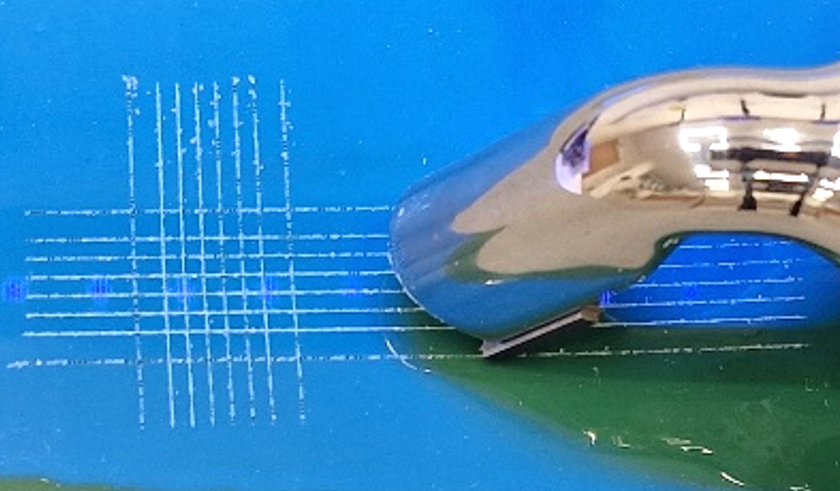 Example of Method B adhesion test performed with 6 cuts blade
Example of Method B adhesion test performed with 6 cuts blade
The blades have a unique angle between 15° and 30° and are spaced at 1 mm or 2 mm.
- 1 mm spacing for coating thickness up to 50 microns
- 2 mm spacing for coating thicker than 50 microns
For context, Method A is recommended to be used for thicknesses above 125 microns
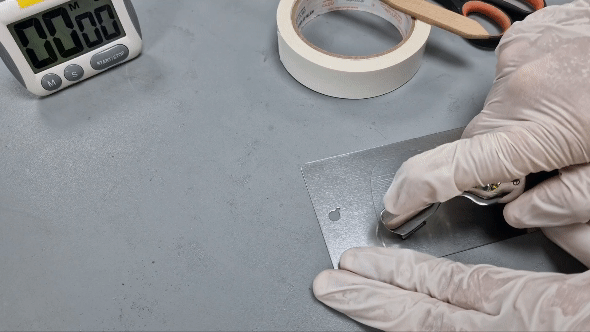
Cuts are made at a consistent pressure into a fully cured board. After the first cut, the board is rotated 90° before a second cut is made. Tape is applied and required to rest for 60 seconds before removal. Remove the tape firmly.
The adhesion tape is recommended to be certified as per ASTM D3359 standard for optimum pull strength.
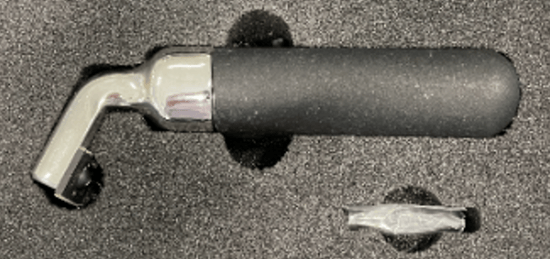
 The Tool and Tape used at HumiSeal
The Tool and Tape used at HumiSeal

6x1 mm and 6x2 mm Blades
Common Mistakes for Method B Cross-Cut Adhesion Test
Through our many years of practice, we've assembled some helpful tips to ensure you get the most accurate results possible when conducting adhesion tests. Keep the following in mind:
-
Coatings must be fully cured as per the TDS recommendations
-
The type of blade used is based on the thickness, be sure you have the right equipment for your coating
-
Positioning of the tool and force is critical for achieving clean cuts
-
Following the standard instructions on how to place and remove the tape
-
Quality of the blade. The blade is recommended to be replaced every 50 cuts.
Additionally, there are two primary reasons to conduct adhesion testing.
For material qualification:The coating material can be applied on:
- A flat surface, generally FR4 panel with similar solder mask as the production assemblies
- Unpopulated PCB panel
- PCB panel with solder paste but no components
- Coated assembly with components (generally adhesion test is done on an area without components. Minimum flat surface required 50 x 50 mm)
Related Article: A Quick Guide on Manually Brushing Conformal Coatings
Performing and Analyzing the Adhesion Test
We've talked about many of the considerations and steps already, but as a quick reminder:
- Coat and cure the board with conformal coating
- Using the proper tool, make the cuts. With a consistent pressure and angle:
- Score one line of cuts
- Rotate the board
- Score the second line of cuts perpendicular to the first
- Apply certified tape to the board
- After letting the tape rest for 60-90 seconds, remove the tape firmly at a 180° angle
- Analyze results (see below)
We've assembled a video guide explaining the process for PCB adhesion tests. Please review it for essential instructions and considerations.
Analyzing Adhesion Test Results
The following chart is pulled directly from the ASTM D3359 standard:
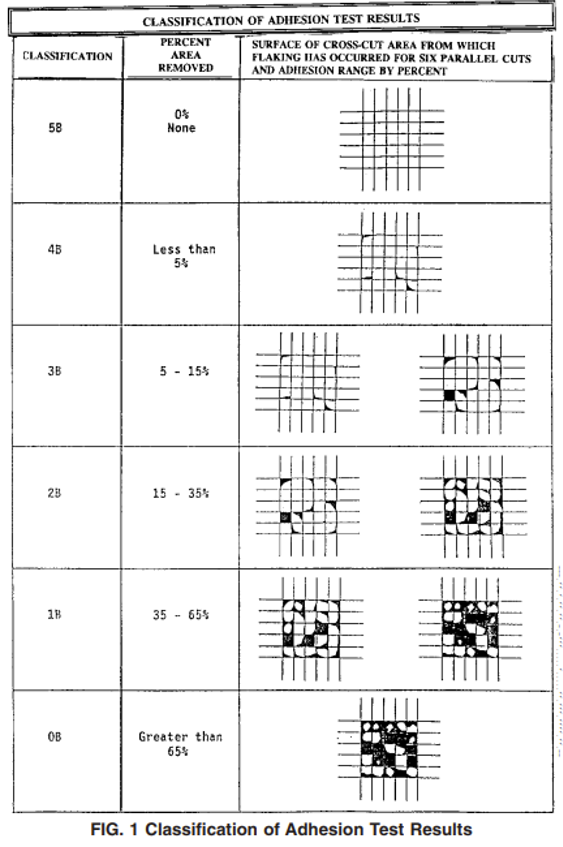
For examples of how these results may look on a real PCB, here are some example UV-curable conformal coating results:

Interpretation of the results:
0B – majority of coating is pulled from the cut area
2B – deep scratches and coating pulled from some of the squares
4B – deep scratches with minor delamination along the lines, but no coating is pulled
5B – clear lines with no delamination
4B and 5B ensured good quality of the coating when the same conditions are maintained:
- Surface energy of the substrate
- Level of contamination on the PCB surface
- Coating application, thickness, and curing method
Related Article: The 3 Most Common Problems of Modern Conformal Coating Application
Getting proper adhesion for your conformal coating material is essential. Application errors that result in delamination or peeling impose a good deal of risk onto the circuit board. We have also seen and assisted with conformal coating bubbling and conformal coating cobwebbing or wicking, two similarly dangerous conformal coating errors.
If you have any questions on conformal coating applications, please leave a comment or reach out with our Contact Us button. As a supplier of all major forms and chemistries of conformal coatings, Chase Corporation and HumiSeal® can help you with an unbiased approach to evaluating your application and process. We’ll show you how to maximize efficiency, minimize cost, and improve product reliability. Our outstanding manufacturing and technical support groups can provide your organization with reliable global supply, unmatched quality, and superior technical support.








